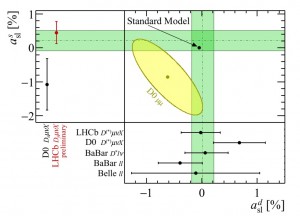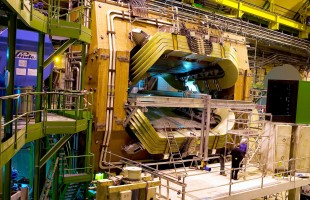
De meting van LHCb geeft aan dat asls=(0.45 ± 0.26 ± 0.20)%. Dit is consistent met de voorspelling van het Standaard Model. In de figuur zijn de datapunten pure metingen van asls en asld. In het rood is de nieuwe, nauwkeurige meting van LHCb weergegeven. De groene banden geven het gemiddelde van alle pure asls en asld metingen weer. In het twee-dimensionale vlak is ook een meting van het D0 experiment (geel) te zien. Deze waarde wijkt af van het Standaard Model. Jacco de Vries, de promovendus die de resultaten in Marseille presenteerde, verklaart: “De nieuwe meting van LHCb, in combinatie met de asld metingen, lijkt de meting van D0 te ontkrachten. Een verklaring voor de afwijkende waarde van D0 moet waarschijnlijk worden gezocht in een statistische fluctuatie of in andere effecten en niet in een afwijking van asls of asld“.
Meer informatie:
Afdeling Wetenschapscommunicatie – e-mail – 020 592 5075
Jeroen van Tilburg, onderzoeker LHCb-Nikhef – e-mail – 020 592 2131
Marcel Merk, programmaleider LHCb-Nikhef – e-mail – 020 592 5107
English
New precision measurement from LHCb sees no difference between Bs and anti-Bs particles
A new measurement with Bs mesons has been presented this week at the 16th International Conference on B–Physics at Frontier Machines in Marseille. These particles consist of an s quark and an anti-b quark (Bs) or an anti-s quark and a b quark (anti-Bs). They have a short lifetime, about 1.5 picoseconds, however, this is quite long for such heavy particles. In this short time, they travel on average one centimeter through the detector. During this flight, something remarkable happens: a Bs can transform in an anti-Bs and vice versa. This quantum-mechanical phenomenon is called mixing, or in this case Bs mixing. It may happen that the probability for a Bs to transform in an anti-Bs is different from the reverse process that an anti-Bs transforms in a Bs. This is called CP violation in mixing and is described by the parameter asls. For Bd particles (here the s quark is replaced by a d quark) the corresponding parameter asld has been measured before, a.o. by LHCb. In the Standard Model of particle physics this parameter is basically zero. This means that if a significant deviation from zero is measured, this could be a hint for the presence of new, unknown particles in these transitions.
The LHCb measurement shows that asls=(0.45 ± 0.26 ± 0.20)%. This is consistent with the Standard Model prediction. In the figure, the data points are pure measurements of asls and asld. The new precision measurement from LHCb is displayed in red. The green bands show the average of all pure measurements of asls and asld. In the two-dimensional plane, another measurement from the D0 experiment shown in yellow. This result deviates from the Standard Model. Jacco de Vries, who presented these new results in Marseille, explains: “This new LHCb measurement, in combination with the asld measurements, seems to contradict the D0 measurement. A possible explanation for the D0 deviation can be a statistical fluctuation or other effects, but apparently not a deviation of asls or asld.”
More information:
Science Communications Department – e-mail – 020 592 5075
Jeroen van Tilburg, researcher LHCb-Nikhef – e-mail – 020 592 2131
Marcel Merk, programme leader LHCb-Nikhef – e-mail – 020 592 5107

